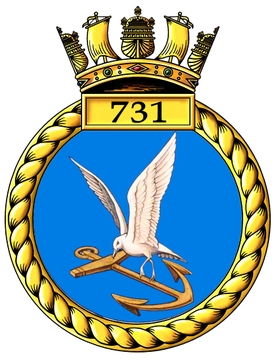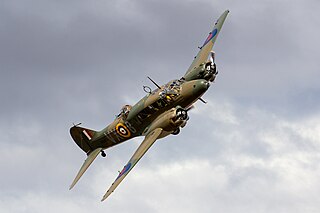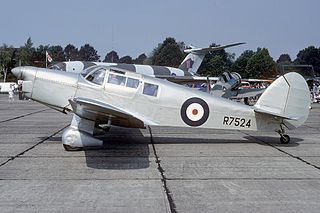
778 Naval Air Squadron was a Naval Air Squadron of the Royal Navy's Fleet Air Arm. During the Second World War the squadron was a Service Trials Unit (STU) initially based at HMS Daedalus, RNAS Lee-on-Solent, Hampshire, England before moving to HMS Condor, RNAS Arbroath, Angus, Scotland on 6 July 1940. The squadron tested all types of aircraft that could be used by the Royal Navy. Key to this was testing new types for deck landing on aircraft carriers. Such aircraft included various types of Supermarine Seafires, Grumman Hellcats, Grumman Martlets, Grumman Avengers, and Vought Corsairs. The squadron was reformed on 5 November 1951 with Douglas Skyraider AEW.1 but was disbanded on 7 July 1952 to form the basis of 849 Naval Air Squadron.

886 Naval Air Squadron was a Naval Air Squadron of the Royal Navy's Fleet Air Arm. It was formed at HMS Merlin, RNAS Donibristle, as a Fleet Fighter squadron during March 1942. The squadron was loaned to RAF Fighter Command during the summer of 1942, returning the Fleet Air Arm later on in the year. 1943 saw it participate in Operation Avalanche, part of the Allied invasion of Italy. The following year it was involved with operations over Normandy, spotting for the allied invasion of France from 6 to the end of June 1944, disbanding the following month.

731 Naval Air Squadron was a Naval Air Squadron of the Royal Navy's Fleet Air Arm (FAA). It was active between 1943 and 1945 and its sole role throughout its formation was a Deck Landing Control Officer training squadron. Through this role the squadron pilots were nicknamed 'Clockwork Mice'. It was based out of the purpose built airbase, commissioned as HMS Peewit, known as Royal Naval Air Station East Haven, in Scotland, as part of the Deck Landing Training School there.

741 Naval Air Squadron was a Naval Air Squadron of the Royal Navy's Fleet Air Arm which last disbanded during November 1947. It was initially active, between March 1943 and March 1945 as an Observer Training Squadron at HMS Condor, RNAS Arbroath, Scotland, as part of the No. 2 Observer Training School. It reformed at HMS Vulture, RNAS St. Merryn, England, as an Operational Flying Training Unit in August 1946.

747 Naval Air Squadron was a Naval Air Squadron of the Royal Navy's Fleet Air Arm which last disbanded in December 1945. 747 Naval Air Squadron was part of the Torpedo Bomber Reconnaissance Pool and formed at HMS Owl, RNAS Fearn, in March 1943, evolving into an Operational Training Unit. July saw the squadron move to HMS Nightjar, RNAS Inskip and became part of No. 1 Naval Operational Training Unit. It returned to HMS Owl in January 1944 and then to HMS Urley, RNAS Ronaldsway, in July. In November 1945 the squadron headquarters moved to HMS Jackdaw, RNAS Crail, leaving a Flight at HMS Urley.

753 Naval Air Squadron was a Naval Air Squadron of the Royal Navy's Fleet Air Arm. It was active as an Observer Training Squadron from 1939 to 1946 as part of No. 2 Observer School, forming out of the School of Naval Co-operation RAF, in May 1939. Initially at RNAS Lee-on-Solent, the squadron moved to RNAS Arbroath just over one year later in August 1940, following a German bombing attack on the air station. It spent four years operating out of Arbroath, before relocating again, this time to RNAS Rattray, where the squadron disbanded in August 1946.

756 Naval Air Squadron was a Naval Air Squadron of the Royal Navy's Fleet Air Arm. It was initially formed as a Telegraphist Air Gunner Training Squadron, operating from May to August 1939, out of RNAS Worthy Down, in Hampshire, England. It was later reformed again as a Telegraphist Air Gunner Training Squadron, operating from March 1941, out of RNAS Worthy Down. TAG training was provided until the No. 2 School was ready in Canada, opening on 1 January 1943, and 756 Naval Air Squadron disbanded in December 1942. The squadron reformed at RNAS Katukurunda, in Sri Lanka, in October 1943, as a Torpedo, Bomber, Reconnaissance pool. During 1944 and 1945, the squadron undertook a number of detachmemts on different types of Royal Navy aircraft carriers, then disbanding in December 1945.

759 Naval Air Squadron was a Naval Air Squadron of the Royal Navy's Fleet Air Arm. It was created on November 1, 1939, and was disbanded on December 24, 1969. It was initially intended as a Telegraphist Air Gunner Training Squadron but became a Fighter School and Pool Squadron in 1939, at RNAS Eastleigh. It operated out of RNAS Yeovilton from 1940 to 1946, as part of the Naval Air Fighter School. In 1943 a detachment operated out of RNAS Angle, working with 794 NAS and known as the Naval Air Firing Unit. It was again the Naval Air Fighter School upon reformation in 1951 and disbandment in 1954, firstly at RNAS Culdrose and then moving to RNAS Lossiemouth, in 1953. The squadron reformed again, this time at RNAS Brawdy in 1963, as the Naval Advanced Flying Training School, before finally disbanding in 1969.

768 Naval Air Squadron was a Naval Air Squadron of the Royal Navy's Fleet Air Arm (FAA). It last disbanded at HMS Gannet, RNAS Eglinton, Northern Ireland, in March 1949, having been formed as a Deck Landing Control Officer Training Squadron, in December 1948, to ensure one American-style signal trained DLCO could be located at every FAA station. It first formed as part of the Deck Landing Training School at HMS Condor, RNAS Arbroath, in January 1941, as a Deck Landing Training Squadron. Advanced training was in HMS Argus, for which a detachment was maintained at HMS Landrail, RNAS Machrihanish, where it wholly moved to in March 1943. September saw a move to RAF Heathfield, Ayr, followed by a further move to HMS Sanderling, RNAS Abbotsinch in January 1944. Training used escort carriers on the Firth of Clyde and a detachment was maintained at (Heathfield)Ayr throughout this period, with the squadron returning there in July 1945, at this time HMS Wagtail, RNAS Ayr. In August the squadron moved to HMS Corncrake, RNAS Ballyhalbert in Northern Ireland but then in October it joined up with the Deck Landing School at HMS Peewit, RNAS East Haven, Scotland, where it disbanded in April 1946.

769 Naval Air Squadron was a Naval Air Squadron of the Royal Navy's Fleet Air Arm. It last disbanded and merged with 717 Naval Air Squadron after the Second World War. 769 Naval Air Squadron Formed at HMS Merlin, RNAS Donibristle, during May 1939, by renumbering 801 Naval Air Squadron. Its role was a fighter Deck Landing Training Squadron, using HMS Furious for advanced training, before disbanding in the December. It reformed in November 1941, as a unit within the Deck Landing Training School at HMS Condor, RNAS Arbroath, and in November 1943, it moved to HMS Peewit, RNAS East Haven. Its role changed to Torpedo Bomber Reconnaissance Training in 1944, before moving to HMS Merganser, RNAS Rattray, in July 1945.

770 Naval Air Squadron was a Naval Air Squadron of the Royal Navy's Fleet Air Arm. It last disbanded at HMS Nighthawk, RNAS Drem in October 1945. 770 Naval Air Squadron initially formed as a Deck Landing Training Squadron at HMS Daedalus, RNAS Lee-on-Solent, in November 1939. Embarked in HMS Argus, and operated from the aircraft carrier and Hyeres la Palyvestre in the south of France, until it disbanded in May 1940. It reformed at HMS Merlin, RNAS Donibristle, on New Year’s Day 1941, as a Fleet Requirements Unit out of 771 Naval Air Squadron’s 'X' Flight. It moved to HMS Jackdaw, RNAS Crail, in June 1941, then two and half years later it moved to HMS Jackdaw II, RNAS Dunino in January 1944, before finally moving to HMS Nighthawk in July.

775 Naval Air Squadron was a Naval Air Squadron of the Royal Navy's Fleet Air Arm which last disbanded in March 1946. 775 Naval Air Squadron formed at HMS Grebe, RNAS Dekheila, during November 1940, as a Fleet Requirements Unit in support of the Mediterranean Fleet, based at Alexandria, Egypt. Between October 1941 and March 1942 the squadron also included the RN Fighter Flight. It absorbed 728 Naval Air Squadron in July 1943 and moved to R.N.Air Section Gibraltar at the start of February 1944. The squadron returned to HMS Grebe, RNAS Dekheila during August 1945.

776 Naval Air Squadron was a Naval Air Squadron of the Royal Navy's Fleet Air Arm which last disbanded at the end of October 1945. 776 Naval Air Squadron formed as a Fleet Requirements Unit at HMS Daedalus, RNAS Lee-on-Solent, at the start of 1941. It operated a detachment at RN Air Section Speke in 1941 and one at RAF Woodvale in 1942, with the squadron wholly moving to Speke in the October. 1943 saw further detachments and these were deployed at RAF Llanbedr, RAF Millom, RAF Usworth and RAF Waltham. In April 1945, the Woodvale detachment was reabsorbed into the squadron when it relocated there, the airbase now operated by the Admiralty and known as HMS Ringtail II. It moved to HMS Ringtail, RNAS, Burscough, at the start of October 1945.

777 Naval Air Squadron was a Naval Air Squadron of the Royal Navy's Fleet Air Arm, which formed as a Fleet Requirements Unit in West Africa during the Second World War. Throughout most of 1943, the squadron was responsible for the air defence of Sierra Leone. It disbanded at HMS Spurwing, RNAS Hastings, Sierra Leone, during December 1944. The squadron reformed in May 1945, from 'B' Flight of 778 Naval Air Squadron, as a Carrier Trials Unit operating aboard HMS Pretoria Castle, and using shore bases at HMS Siskin, RNAS Gosport, and HMS Peregrine, RNAS Ford in England, and HMS Wagtail, RNAS Ayr, in Scotland. 777 Naval Air Squadron number was assigned to the aircraft collection at the Fleet Air Arm Museum in April 2006.

780 Naval Air Squadron was a Naval Air Squadron of the Royal Navy's Fleet Air Arm which last disbanded at HMS Seahawk, RNAS Culdrose in November 1949. 780 Naval Air Squadron formed at HMS Raven, RNAS Eastleigh as a Conversion Course Unit, in October 1939, to train experienced civilian pilots in naval flying. It moved to HMS Daedalus, RNAS Lee-on-Solent, in October 1940, and later, its role had changed to converting pilots to Fairey Barracuda aircraft. It spent a year at RNAS Charlton Horethorne, before returning to HMS Daedalus and disbanded, early 1945. In March 1946, the squadron reformed at HMS Godwit, RNAS Hinstock, as the Naval Advanced Flying School, to give flying instructors' courses, and later provided Instrument Flying Training. In December, the squadron moved to HMS Jackdaw, RNAS Crail, then in March 1947 moved to HMS Merlin, RNAS Donibristle, and in May to HMS Seahawk as the first resident unit.

787 Naval Air Squadron was a Naval Air Squadron of the Royal Navy's Fleet Air Arm which disbanded in January 1956. It formed in March 1941, at HMS Heron, RNAS Yeovilton, out of 804 Naval Air Squadron as a Fleet Fighter Development Unit. Almost every type of fighter was received by the squadron for testing and evaluation for naval use. A move to RAF Duxford in June 1941 saw it become the Naval Air Fighting Development Unit, attached to the Royal Air Force's Air Fighting Development Unit. The squadron undertook rocket projectile test, continuous development of fighter tactics and even helping Torpedo Bomber Reconnaissance squadrons in evading fighter attack. Post Second World War it continued its trials task and also undertook Rebecca radar trials and ASH, US-built air-to-surface-vessel radar trials.

788 Naval Air Squadron was a Naval Air Squadron of the Royal Navy's Fleet Air Arm which last disbanded during June 1945. The squadron formed at RN Air Section China Bay in Ceylon, in January 1942, as the British Eastern Fleet's Torpedo Bomber Reconnaissance Pool, however it lost half its strength during the heavy raids by Japanese carrier-borne aircraft in the April. The squadron regrouped at RNAS Tanga in Tanganyika, East Africa to become a Fleet Requirements Unit and relocating almost immediately to RN Air Section Port Reitz, in Mombasa, where it remained operational for the next three years.

791 Naval Air Squadron was a Naval Air Squadron of the Royal Navy's Fleet Air Arm which last disbanded at Sembawang in June 1947. It formed as an Air Target Towing Unit, at HMS Condor, RNAS Arbroath, in Scotland, in October 1940. It operated various types of aircraft for target towing duties, used to support air gunnery training and practice. The squadron disbanded in December 1944, at Arbroath. It reformed at RNAS Trincomalee, in British Ceylon,, in November 1945, as a Fleet Requirements Unit. The squadron moved to RNAS Sembawang, in Singapore, in December 1945, ferried via the escort carrier, HMS Smiter. It also operated a Communications Flight and an Air-Sea Rescue Flight, as well as undertaking anti Mosquito spraying duties.

796 Naval Air Squadron was a Naval Air Squadron of the Royal Navy's Fleet Air Arm which last disbanded at RNAS Culdrose in October 1958. 796 Naval Air Squadron formed as the Eastern Fleet Torpedo Bomber Reconnaissance Pool, at RN Air Section Port Reitz, in Mombasa, in July 1942, it provided a detachment embarked in HMS Illustrious in August to support the invasion of Madagascar. This Flight also disembarked to Majunga in September to join 207 Group of the Royal Air Force and later rejoined the squadron at RNAS Tanga, in November and added operational training unit to its roles until disbanding in April 1944. It reformed in November 1947 at HMS Vulture, RNAS St Merryn, as the Aircrewman Training School, for conversion of T.A.G.'s to aircrewman standard. Its task changed to Observer School Part II in January 1950. The squadron moved to HMS Seahawk, RNAS Culdrose, in November 1953 and in 1957 took on the task of the disbanded 765 Naval Air Squadron.

797 Naval Air Squadron was a Naval Air Squadron of the Royal Navy's Fleet Air Arm which last disbanded in October 1945 in Ceylon. Its role was a Fleet Requirements Unit which formed at HMS Ukussa, Royal Naval Air Station Katukurunda, in Ceylon, in July 1942. The squadron moved to RNAS Colombo Racecourse in October 1943. It had a Communications Flight which became 742 Naval Air Squadron in December 1943 and the following summer it had an ‘X’ Flight deployed for target towing for a couple of gunnery schools in Bombay, India and which eventually moved to 722 Naval Air Squadron.





















